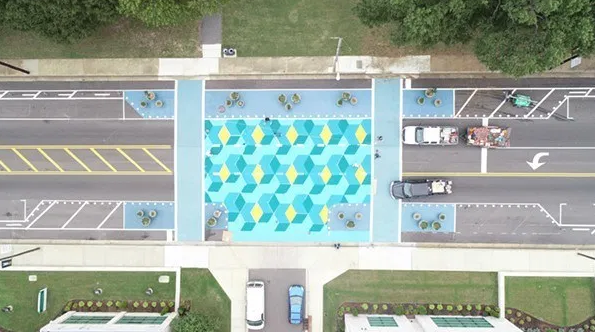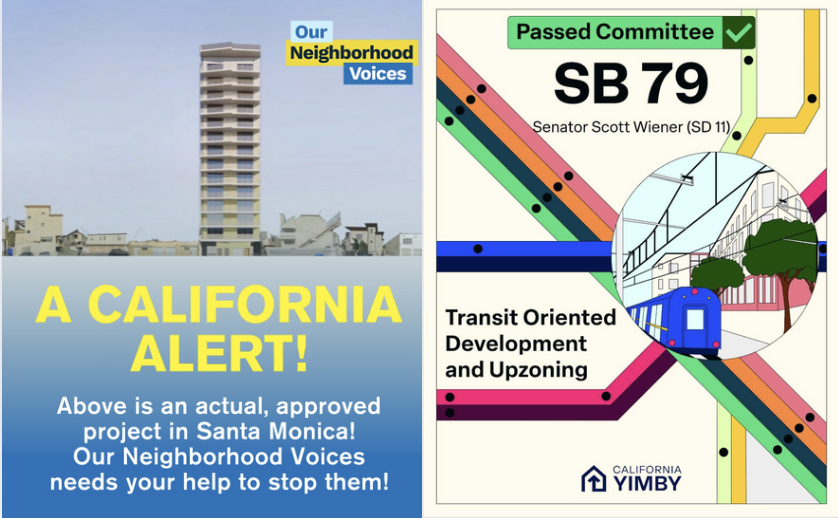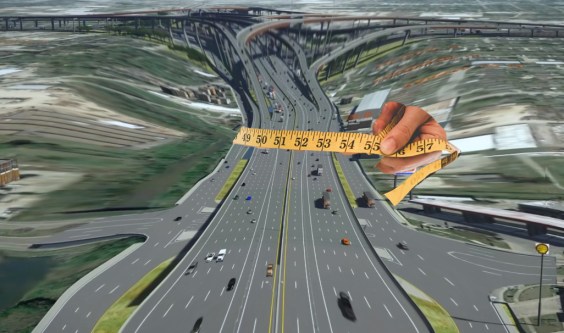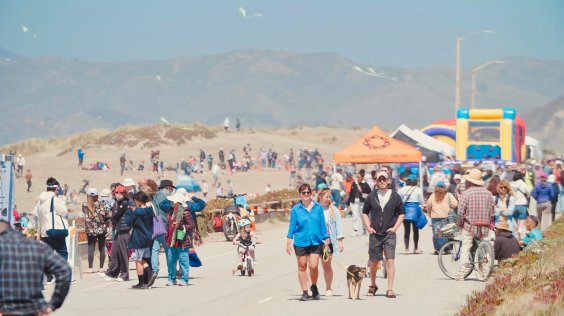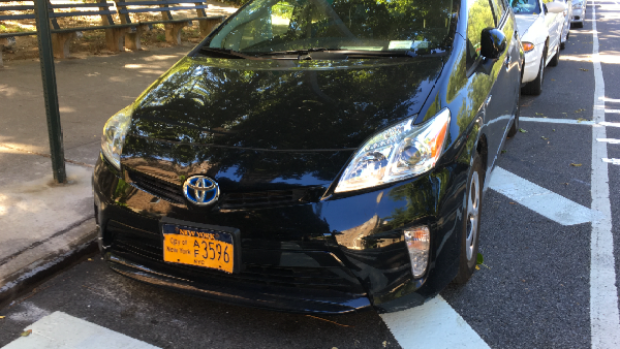 The federal government is continuing to crack down on crosswalk art and colorfully painted intersections without hard evidence that the street designs — which have become a popular way to brighten up (and make safer) avenues across the nations — is adversely affecting traffic.
The federal government is continuing to crack down on crosswalk art and colorfully painted intersections without hard evidence that the street designs — which have become a popular way to brighten up (and make safer) avenues across the nations — is adversely affecting traffic.
Since the early 2000s, when it declared that then-new, more highly reflective paint had no affect on highway safety, the Federal Highway Administration has routinely chided cities that have had the audacity to add a little color to their crosswalks in hopes of making streets more pedestrian friendly.
Ames, Iowa was the latest municipality to be scolded by the nation's roadway rulers after painting a crosswalk something other than white — in this case with rainbow colors to celebrate inclusiveness — in the FHA's attempt to ensure a homogeneous hue on streets across the Land of the Freeway.
But critics charge the government has never done a single study to prove its point.
"The federal stance is not based on data," said Michael Lydon, one of the principals of Street Plans, an urban design firm. " There has never been a study."
Still, that hasn't stop the feds from asking leaders in St. Louis to put an end to the Gateway City's popular crosswalk and intersection art back in 2016 or reprimanding honchos in Lexington, Kentucky a year later when they also painted a crosswalk the colors of the rainbow.
The Kentucky removal particularly peeved Lydon, who said that piece of street art saved lives.
"That was at an intersection with almost 10 crashes a year," he said. "After it went in, it went down to zero. But the state DOT there too them to get rid of it because of the letter from [the federal authorities]."
And locals living near new street art in Rochester, New York told local radio station WXXI that the rainbow designs there calmed traffic on streets that were less than pedestrian friendly.
"Cars slowed down," longtime resident Joseph Hutchings said. "Ain't nobody speeding up right here no more. People feel safer."
But the Highway Administration doesn't see it that way, ruling in its report that "crosswalk art is actually contrary to the goal of increased safety and most likely could be a contributing factor to a false sense of security for both motorists and pedestrians."
No data supports that ruling. The Federal Highway Administration did not respond to a request for comment.
Some cities that install crosswalk art or other street art for simply artistic purposes are yet to feel the brunt of the feds ruling.
Officials in Portland, Oregon have never been asked to remove crosswalk art installed in the Old Town section of that city back in 2015. And its popular street painting project, in which intersections and even mid-block areas are covered in creative designs, has never been admonished by the feds, according to Hannah Schafer of the city's Bureau of Transportation.
"Those are more about getting the community outside and talking to each other," she said.
Lydon added that such projects can have a traffic calming effect, but that is not the point.
"Communities do it for the art," he said. "If it happens to slow traffic, it's a side benefit."
Newer-style 3D crosswalks, which designers say can slow traffic because they appear to rise from the street thanks to optical illusions, are yet to specifically be attacked by feds despite the fact they don't conform to their standards.
Still, they are popping up across the country. In Medford, Massachusetts, a 10-year-old student convinced officials to paint such a crosswalk near her school to slow traffic earlier his year, and the results, according to the students, teachers, and city officials, have been stellar.
City employees are getting into more preventable and injury-causing collisions while behind the wheel of their taxpayer-funded government cars, new data show.
The number of crashes where the city driver was determined to be at fault went up in fiscal year 2019 compared to the previous July-June period, during which time the size of the city’s overall fleet declined slightly, according to the annual Mayor’s Management Report.
So even as the city’s total fleet size shrunk .8 percent from 31,002 to 30,755, the number of collisions the city deemed preventable went up about .3 percent, from 3,347 to 3,357. At the same time, injuries were also up — from 763 people injured to 827, an increase of more than 8 percent. Fatalities doubled from two people to four.
The increase in crashes that caused injuries or deaths is odd, considering that overall collisions decreased slightly, from 6,304 in 2018 to 6,061 in 2019.
Which agency has the worst drivers? The city calculates the safety record of the agencies with the largest city-managed fleets by ranking the number of collisions per 100,000 miles of travel. Based on that, here are the agencies ranked from worst crash rate to best:
- FDNY (10.1 collisions per 100,000 miles)
- Sanitation (7.6)
- Parks (4.7)
- NYPD (4.4)
- Department of Citywide Administrative Services (2.9)
- Environmental Protection (2.8)
- Transportation (2.7)
- Correction (2.5)
- Department of Health (1.6)
The city first started tracking the number of crashes involving drivers of government vehicles in 2015, Streetsblog reported at the time. Each agency is required to investigate all crashes in order to determine the cause, and respond appropriately, whether that means additional training or discipline for the employee, according to a spokesman for DCAS.
But even one injury or death is one too many, according to agency spokesman Nick Benson, who said that since the launch of Mayor de Blasio’s signature Vision Zero initiative in 2014, city drivers have gotten into fewer crashes.
“The City of New York made a commitment to safer streets that is yielding real results. One injury or fatality involving a city vehicle is too many, but significant progress has been made,” he said. “Collisions per mile, injuries per mile, and the number of fatalities involving city vehicles have all declined since [the] launch” of Vision Zero.
The best way to prevent crashes, of course, is to eliminate driving privileges for city workers. Beyond that, the city admits it needs to step up its effort to fully train its workers in defensive driving. According to the report, the city intended to train 85 percent of its employees in defensive driving by the end of FY2019, yet only got to 82 percent. And several agencies, including the Department of Citywide Administrative Services, the Department of Environmental Protection, and the Department of Correction, fell way short of that goal.
Corrections, which has a fleet of 675 vehicles, did the worst job of training its employees, failing to train 76 percent of its employees in defensive driving.
But Benson, the DCAS spokesman, said that for fiscal year 2019, the city “far exceeded” its goal of training 8,500 people in defensive driving by actually training a total of 10,307 people, and that employees are required to receive training once every three years.
Benson also noted that the rate of collisions per 100,000 miles of travel has gone down for the last four years, along with the rate for preventable collisions. The rate for injuries from collisions has declined since fiscal year 2015, but remained unchanged since last year, he said.
But until the city reaches its ultimate goal of getting traffic fatalities down to zero, taxpayers were forced to cough up millions of dollars last year to pay the victims of crashes involving a city vehicle. In 2018, the city spent a whopping $114.2 million to settle suits against the drivers of city vehicles who injured someone, according to the Comptroller’s office. Suits against drivers are the single biggest cause for payouts to victims, even more than police brutality, violations of civil rights or medical malpractice.
And in addition to the millions in settlements, the city must also pay to maintain and upgrade its vehicle fleet. In fiscal year 2019, the city purchased 2,847 new vehicles (down from 3,709 the year before), and paid $274.2 million for maintenance. The city also paid $66.7 million for 29 million gallons fuel in fiscal year 2019 — roughly 406,000 gallons more than the city wanted to burn, according to the report.
